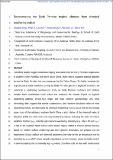Reconstructing Early Permian tropical climates from chemical weathering indices
Abstract
Paleoflora studies suggest that continental drying occurred associated with the Early Permian deglaciation in southern North America, but not in North China. Both regions occupied tropical latitudes during the Early Permian, but they were separated by the Tethys Ocean. To further constrain the tropical paleoclimate conditions during the Early Permian glacial to deglacial transition, we undertook a weathering geochemistry study on Early Permian mudstone and siltstone samples from southeastern North China and evaluated the climate impact on regional weathering patterns. Whole-rock major- and trace-element geochemistry, and X-ray diffraction mineralogy data suggest that sample compositions, and resultant calculated values of most weathering indices, are dominated by chemical weathering from a source akin to the average upper continental crust (UCC) of the adjoining southern North China craton. Values of the chemical index of alteration (CIA) and other well-correlated weathering indices, including the index of sodium depletion fraction (τNa), indicate high chemical weathering intensity (e.g., CIA > 80 and τNa < −0.80) in the southern North China craton source region related to intense climate forcing. Based on modern surface weathering data from granitic landscapes, we propose that the dependence of land surface soil chemical weathering intensity on the air temperature can be described by a τNa-MAT (mean annual temperature) transfer function, where humidity control is demonstrated by the consistently high τNa values of surface soils at sites with low annual precipitation rates (<400 mm/yr) despite temperature variation. By applying this modern weathering-climate relationship, we compare the Early Permian (Asselian-Sakmarian) terrestrial climate between North China and west tropical Pangea (present-day west Colorado). Using the southern North China craton as an average source composition, the average τNa value of ∼−0.90 for the Asselian-Sakmarian sediments of North China transforms to a MAT of ∼20 ± 2.7 °C and suggests a warm-humid climate. Using average UCC as an average source composition, the Asselian-Sakmarian loessites in west Colorado have an average τNa value ∼−0.20, which either denotes an arid climate or corresponds to a cold (or cold-dry) climate with MAT of ∼4 ± 2.7 °C. If valid, this estimated MAT is consistent with inferred upland glaciation within the ancestral Rocky Mountains of west tropical Pangea. The τNa-MAT transfer function provides a quantitative method for deep-time paleoclimate study and enhances our understanding of the dependence of continental chemical weathering on climate conditions.
Citation
Yang , J , Cawood , P A , Du , Y , Li , W & Yan , J 2016 , ' Reconstructing Early Permian tropical climates from chemical weathering indices ' , Geological Society of America Bulletin , vol. 128 , no. 5-6 , pp. 739-751 . https://doi.org/10.1130/B31371.1
Publication
Geological Society of America Bulletin
Status
Peer reviewed
ISSN
0016-7606Type
Journal article
Description
This study was financially supported by the National Natural Science Foundation of China (grants 41302083, 41572078), the National Basic Research Program of China (grant 2011CB808800), and the Fundamental Research Funds for the Central Universities (grant CUGL140402), China University of Geosciences (Wuhan). P.A. Cawood acknowledges support from NERC grant NE/J021822/1.Collections
Items in the St Andrews Research Repository are protected by copyright, with all rights reserved, unless otherwise indicated.

